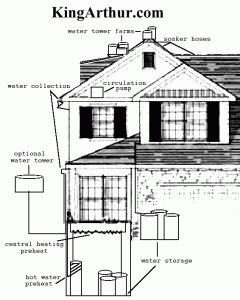About Waterfall Homes and Aqua Living
This article is part of a series on The Waterfall House energy experiment.
Using steam, solar and hydro to help reduce your energy consumption has many benefits. Two of the most obvious benefits are saving money and reducing your “footprint”.
Following are more ideas:
I. What Living In A Waterfall Does
1. cools the house evaporatively (roof irrigation)
2. creates hot water to preheat domestic water and central heating
3. provides garden irrigation
4. increases fire safety
5. delivers an alternative domestic water source
6. helps promote the health and wellness benefits of sun light
II. Main Elements
A. water tower farms
1. bottom feeding water towers
2. siphon feeding water towers
B. water:
collection
storage
distribution
recycling
The out-of-pocket cost to make my dream come true — $338.00 (USD)
(The hidden costs: there’s been some minor water damage, my foot fell through the ceiling, and I got a blood blister on the roof of my mouth while siphoning.)
Improvements To Be Made
Re-cycled Gray Water
I’ve been giving lots of thought to water usage… how you were saying it would take too much water.
That has been a fear of mine… so, I’ve worked on a plan to recover household waste water.
I’ve started sticking a 5 gallon bucket in the shower with me. I try to capture water that is not overly gray (little or no soap… and NO human contaminants.)
This is fairly easy to do. When I’m getting the water temperature ready… or, when I’m just standing there… the water that misses me… goes into the bucket.
Surprise! There was more waste water than I could have imagined (the 5 gal. bucket fills up real FAST.)
PYRAMIDS
The 5 gallon buckets on the roof don’t always empty. (This is due to a wide variety of elevations.)
I found stacking the water towers like a pyramid solved at least 2 problems:
1. the bucket fully drains
2. the water can flow to higher parts of the roof. Raising the right bucket to the top of the pyramid made the water flow to my hard to reach areas.
LOCKS
Getting water from lower elevations to the roof can be done without too much trouble by creating a series of levels (or locks.)
Either several pumps, or one pump moved from location to location, can “step” the water up 10-20 feet at a time.
I used one pump (cost 88 dollars).
Stay tuned….

